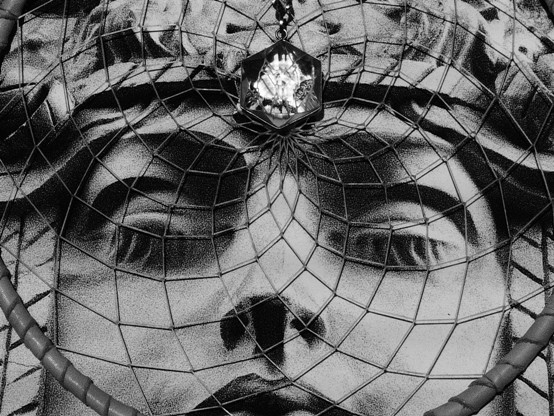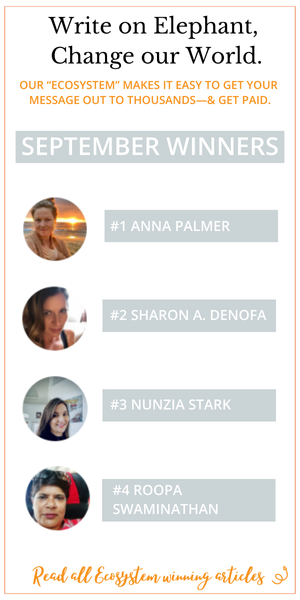Separation. Divorce. Abandonment. Rejection. Betrayal. Loss.
A break-up of a meaningful relationship. A bottomless pit of despair. You have been there. Probably more than once.
Some connections are simply over, the maximum opportunity for learning took its place—you recognize this, acknowledge, release and move on with grace. And some are forced into ending—you recognize this reluctantly, acknowledge it with reservations; the release seems to be impossible, but release you must!
So you find yourself curled up into a sobbing embryonic ball in a ditch, feeling run over by a truck or abducted by aliens. Break-up on the Richter scale of 10: “total destruction of buildings, bridges and roads,” your entire world crumbling and collapsing, your sense of gravity and orientation profoundly shifted from the known reference points. The brain is inflamed and the mind-body connection is severely damaged.
Basically, you are having a funeral for your “happily ever after” dream.
The author Mandy Len Catron calls “falling out of love” an active creation of absence. In relational bond, you have created the whole culture of “two” with its unique language, rituals and habits. Breaking up is an act of erasure of this lost culture.
Imagine a painting, your most prized art-piece of cosmogorial value that is not for sale. Ever. It evokes a sense of home-coming and it is healing to your soul. Just being in its presence makes your heart sing. Now you are looking at the empty frame and the song in your heart is a mere whimper.
From a neurological point of view, empathic loving connections are necessary for our well-being. It is good for the immune system! If a sense of belonging and acknowledgement is linked to our perceived sense of safety, the opposite should also hold true. It is important to address the sense of loss and grief, yet it is vital to remain grounded.
I was aware that it was my own job to recreate the song and to reconstruct the painting into a new masterpiece of my choice, filling it in with the new colors and textures of new experiences and joys. And the only way to do it is through my own mind.
I secretly wished to fast-forward my life to that point in the future. Weeks? Months? Years? If I didn’t know what I know now, I would still be stuck in the perpetual cycle of despair, wallowing in my own self-pity instead of recognizing a huge potential of this time as extremely fertile soil for healing and transformation.
No mud, no lotus, right?
It is not a “12 Easy Steps” program. It is not easy and it is not a program, it is a process. I affectionately refer to it as “Fix My Brain” boot-camp.
A bit of a background first. In a short span of one and a half years I went through a divorce from a 15 year marriage (it was amicable but still emotionally taxing). I moved to a place of my own, started a new career path, got into relationship with the love of my life (as I perceived it), became a full-time mother of a bright nine-year-old boy, watched a friend pass away from cancer and took a decision to break-up with my boyfriend while still being madly in love with him (mutual and extremely hard decision).
The break-up coincided with the funeral. While attending the funeral on a gray rainy day, a few days short of Thanksgiving I had the sense of being at two funerals at once.
I do not have one single family member on this continent—I am originally from the Old World (an adventurous European of a Russian descent that landed in Colorado 15 years ago); all my relatives still reside on the other side of the Atlantic. I didn’t have any time or energy to stay connected with my old social circles and most of my closest friends are scattered throughout the world. To sum it up, the three months post break up was the loneliest, darkest time in my life.
Because I study and teach neuroplasticity meditation, I could predict the emotional challenges ahead of me. I was aware of a huge vacuum to be filled. Most certainly Neurosculpting tools became my saving grace. I already knew the doorway to fixing my heart was through my mind.
I can’t stress enough that if you are going through an emotionally hard time, please realize that this is extremely powerful and precious for your personal growth. I hope you will be convinced by the time you are done reading this. After all, you are going through a threshold of giving a birth to a new self!
To maintain my relative sanity while attending to my daily responsibilities of being a mother and working, my mind had to make sense of what happened. What were the underlying causes? How did I sabotage myself? What role did I play in this two-way dynamic? Why is love not enough? Most importantly, how do I learn my heart’s song again?
So I meditated, I read, I inquired, I asked for help. I entered “Get to Bloody Know Yourself University.” Looking back at this process, three distinctive stages of healing emerge:
Becoming your own Parent
I acknowledge—my ego was shattered to shreds. The old negative “not good enough” story came up like a tidal wave, threatening to overwhelm me and keep me hooked in the circuit of self-pity. From my study of brain neuroplasticity I am aware that our thoughts are not facts, however, they are real and they are neurologically linked to the old patterns and neural maps we have created throughout a life-time.
Emotional pain caused by the thoughts keeps us hooked in the toxic network and is as real as physical pain. Lisa Wimberger in her book Neurosculpting writes:
“Science has only began to unfold and actually map certain mind-body relationships. We have now come to an understanding that the very same neurological pathways in the brain that activate during physical pain can also activate with emotional pain. These neurological implications match what you know in your heart to be true: emotional pain is as real to the mind and body as physical pain.”
Physical sensations reacting to your state of mind in the feedback loop is tangible and it depends on your own story or rather, your relationship to the story. My ego was bruised and raw, like a fresh bleeding wound of a small child that needed my help. Panicking and getting overwhelmed was not an option. I had to get out of my limbic system (part of the brain that houses fight-or-flight center and also part of the brain that would rather keep me in the auto-pilot mode of ‘poor little me’ story) and move into the higher gear of the prefrontal cortex to start acting in a rational, proactive way, like a wise loving parent would.
And like a loving grounded parent, I had to do it with love, empathy and compassion. The prefrontal cortex serves as a CEO of our persona, it is the most evolved part of our brain and is involved into concentration, attention span, judgement, impulse control and critical thinking.
Breathe. Shake. Meditate. Whatever brings you into the present moment. Put away that lost culture of “two” objects, remove your connections from the social media, remove all the triggers that send you into spinning. Gently untangle the emotional cords you have established with your former lover. Most importantly, get on the self-care wagon: eat well, sleep well, exercise. Take care of your basic needs!
Our brains need healthy well-balanced diet to collaborate with the best version of ourselves. Load up on blueberries, turmeric spice, coconut oil, DHA oil, nuts and healthy proteins to boost your brain and speed up your emotional recovery process.
Imagine—what would make your crying inner little child feel loved and nourished on the inside? Our brain loves predictability and sense of safety. Rearranging your home to reflect the sense of “a safe nourishing heaven” is a good start. Create a safe womb of your environment. Surround yourself with signs and reminders of love.
I placed cards and gifts from my dear friends so I could see them daily as a reminder that the story “I’m not worthy of love” is not real! I love water. I tried to indulge myself in hour long bath soaks with essential oils at least once a week. Once the ache seemed unbearable and I cried in a tub, imagining it feeling up with tears and then watch them drain for good. It might sound strange but it was a helpful visualization technique.
Becoming your own parent doesn’t mean distracting yourself from suffering by giving your inner child another shiny object to focus on. It means being ferociously present with your emotions and acknowledging them so you can release them.
Meditation teacher, Cierra Navarra makes a perfect analogy: you hold your quivering heart as if it was a large egg about to break wide open and your job is to provide it with the most nourishing soft and strong support. Guess what’s about to hatch from this egg? It’s a new you! So take heart! You are on your way but you have to be patient and kind to yourself during this time.
Hopefully you’ll learn to maintain this attitude toward yourself for the rest of your life. Promise to be there for yourself always. Healing takes time. Be patient with yourself.
Becoming your own Best Friend
True friends are there for us unconditionally. They can offer a listening ear or a hand to hold. They can be brutally honest and push us into stretching our limits. With friends we can cry and laugh without feeling awkward. We can be ourselves, at our best and our worst and feeling fully connected. Sometimes they tell us to get our heads out of our asses and see things for what they are. Simply put, friendship is healthy. In this stage you rekindle your love of life.
You decide what makes you feel alive.
I literally made a list of “Things that make me happy.” Some of those: jumping a rope in a park, playing music, dancing, going on adventure, taking photos, visiting a new place, having a snowball fight with my son, reading poetry, meditating, brewing green tea in my favorite Japanese teapot, visiting a bookstore, arranging flowers, burning incense, making a collage, playing didgeridoo, having a foot soak, drinking coffee while watching sunset…simple like that.
Definitely spend quality time with friends but most importantly, befriend your spirit. Emotions will rise inevitably.
“Recognize, acknowledge, release” became my mantra. Admittedly I had a big gap in my life to fill but it also allowed me to refocus my energy on other things in life. I thrive on adventure. With a perspective of a lonely Christmas at home (my son went away for the holidays with his father) I arranged a road trip to one of my favorite destinations—Moab, Utah. My spirit recharges in nature. My heart soars whenever I take it out into the wild. On the Christmas Eve I watched Thelma and Louise in my room and watched the magnificent stars outside my humble rental cabin before going to bed. I felt like the most fortunate human alive!
Create new memories and rituals to untangle the old connection and let go. I became my own shaman. I was burning notes and letters. I was setting intentions. I was creating a funeral to the dreams we shared. There is a lot of resistance to letting go, perhaps that is the whole point of the healing process.
Letting go will happen if you don’t cling to the past. It is not about “unloving.” Love is of infinite quality, but the attachment has an expiration date. Realize that your future deserves your full attention. As Mark Twain said: “Plan for the future, because that is where you are going to spend the rest of your life.”
Becoming your own Teacher-Student
My inquisitive mind craves understanding, and now it was demanding more knowledge of my psyche in order to make a perceived sense of order in the emotional chaos.
We are prisoner, prison and a hero that escapes the prison, all rolled into one. To escape this prison of “broken-heart” story, I embarked on educating myself on subjects of emotional intelligence and relationships. I read anything related to relationships I could: psychology, philosophy, neuroscience, digests, blogs, alternative healing modalities, Buddhist texts, metaphysics, scientific research, TED talks.
The most insightful explanation about what goes wrong between two people in love was a psychological phenomenon described by a clinical psychologist Robert W. Firestone, Ph.D. as a “fantasy bond,” or a substitute for a truly loving relationship: each of us develops an attachment pattern that affects everything from our partner selection to how well our relationships progress to, sadly, how they end. It is established in early childhood attachments and continues to function as a working model for relationships in adulthood.
Destructive fantasy bonds, which exist in a large majority of relationships, greatly reduce the possibility couples have of achieving intimacy.
In their research, Dr. Phillip Shaver and Dr. Cindy Hazan found that about 60 percent of people have a secure attachment, while 20 percent have an avoidant attachment, and 20 percent have an anxious attachment.
The latter comes from a framework of insatiable emotional hunger while the avoidant personality develops attitude of not admitting their emotional needs at all, acting in a pseudo-independent way as a coping mechanism of emotional self-preservation.
Two people with the opposite styles of attachment attract each other to work their wounds through, creating this illusion of connection and closeness as an imagination of love and loving. The good news is that the attachment style you developed as a child based on your relationship with a parent doesn’t have to define your ways of relating to those you love in your adult life.
If you come to know your attachment style, you can uncover ways you are defending yourself from getting close and being emotionally connected. Neuropsychiatrist Dr. Daniel Siegel writes on attachment styles: “I loved the way attachment research showed that fate (having less-than-perfect parents) isn’t necessarily destiny. If you can make sense of your life story, you can change it.”
Perhaps in a similar fashion the story of my “new masterpiece” starts re-emerging and becoming a new reality to my brain. In the process of erasing the lost culture of “two,” I’m also erasing my story of “broken heart,” replacing it with a “new whole me” story.
I hope that your grief and emotional turmoil will soon start resembling a profound gift. The gift of deep familiarity with yourself.
I spent most of my life in denial of my feelings. My mind developed strategies to pretend that I don’t have emotional needs, after all my personality is optimistic, adaptable and easy going—an inner child pleading please love me the way I am. My passive-aggressive defence mechanism was a well-oiled machine, functioning perfectly to keep me in a victimhood mentality. By the grace of becoming sick a few years ago and having to face my old unaddressed PTSD from a sexual assault, my life-long ADD-like patterns and now the latest turmoil, I am more familiar with my emotional make-up than I ever was.
As you come closer to your wholeness (the word healing comes from the Old English “haelen” and one of its meanings is “to make whole”) you may agree with this simple idea: a flower blooms not to perform and deliver so it can be appreciated by someone for its beauty and fragrance, it blooms and turns towards the sun simply because it is alive.
The life force running through a flower is the same life force running through you and through all of us. Perhaps, only when you are fully alive, fully present and accept yourself 360 degrees, with all your darkest, shadowy crevices and brightest, most brilliant facets representing the best human qualities in you, you are ready to know the other. What a tremendous gift!
Relephant:
How To Survive A Breakup Without Closure.
Author: Vija Rogozina
Editor: Catherine Monkman
Photo: woollydear/Flickr, Author’s Own










Read 5 comments and reply